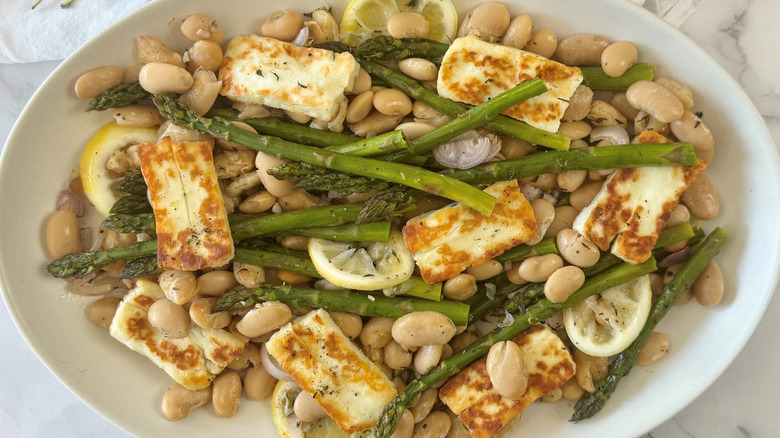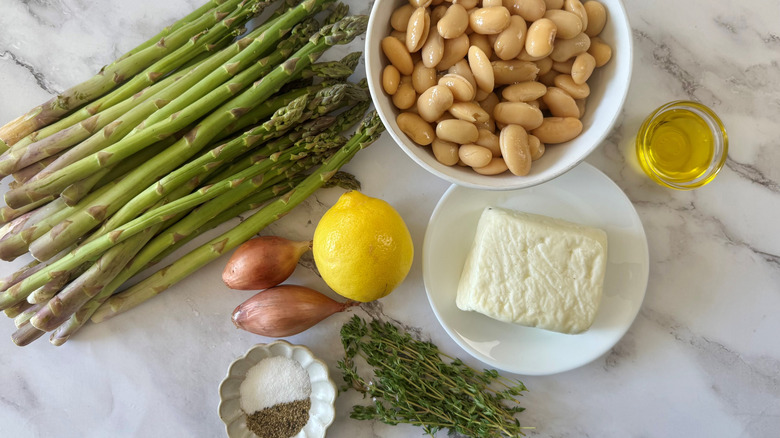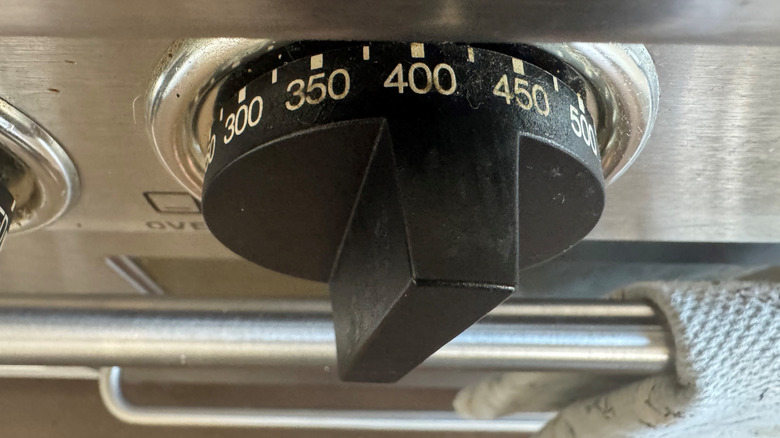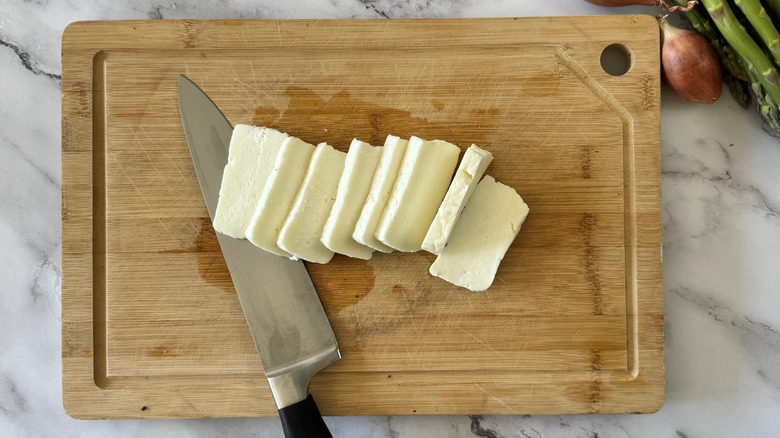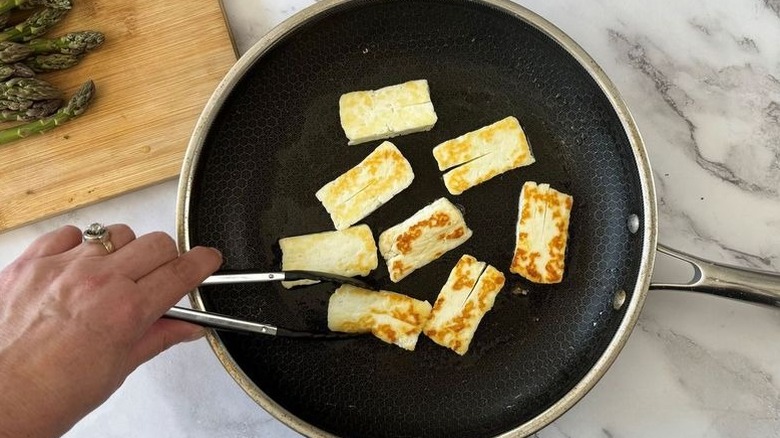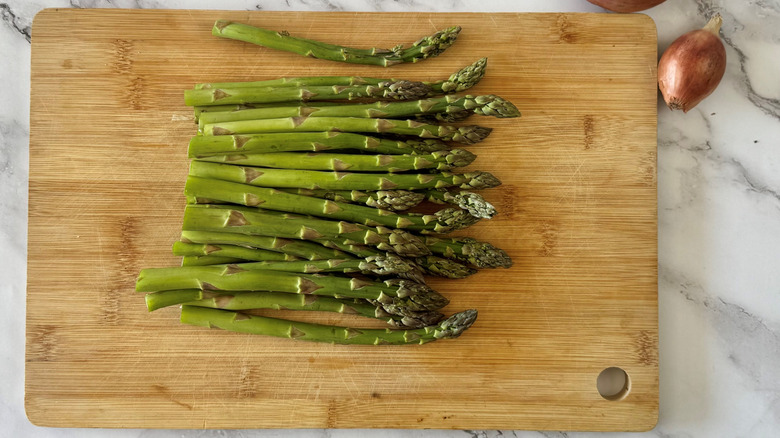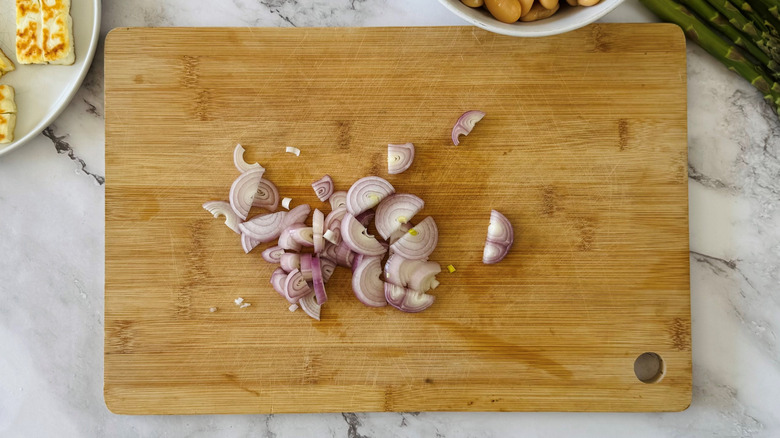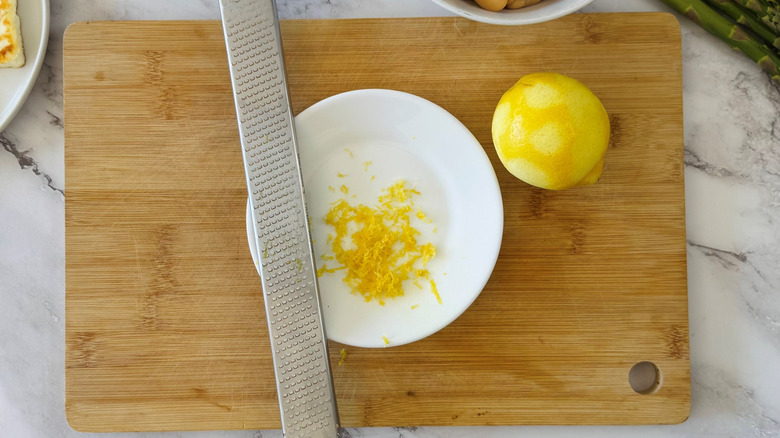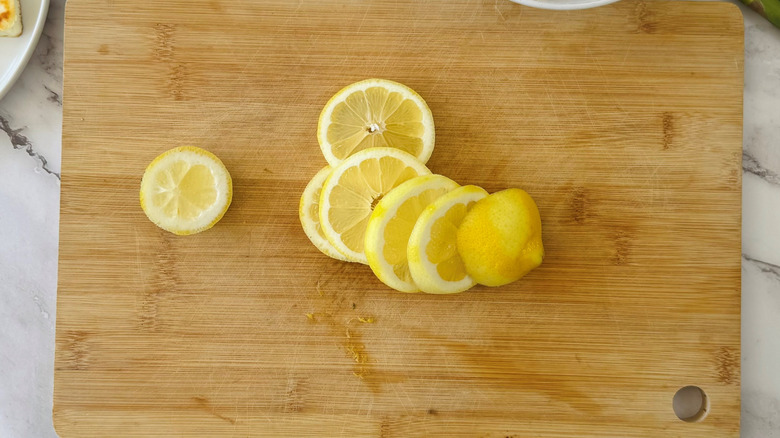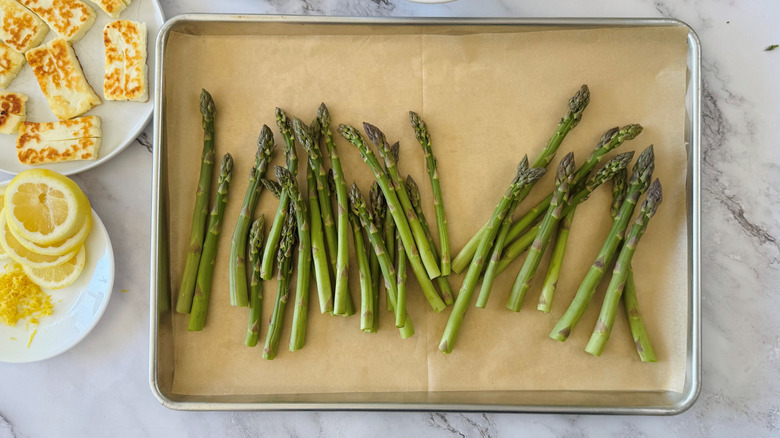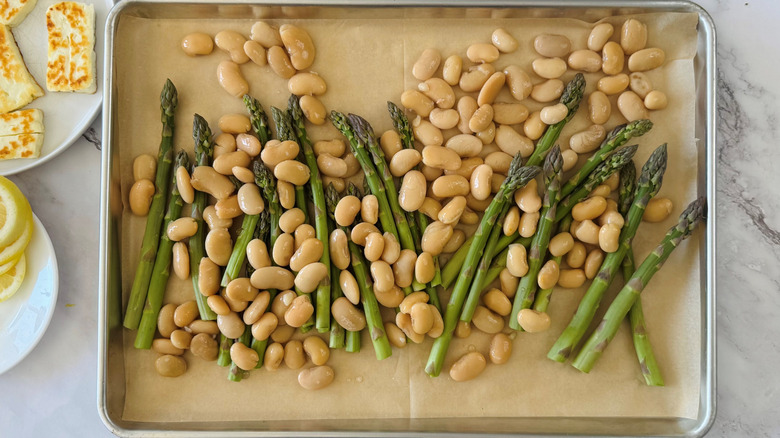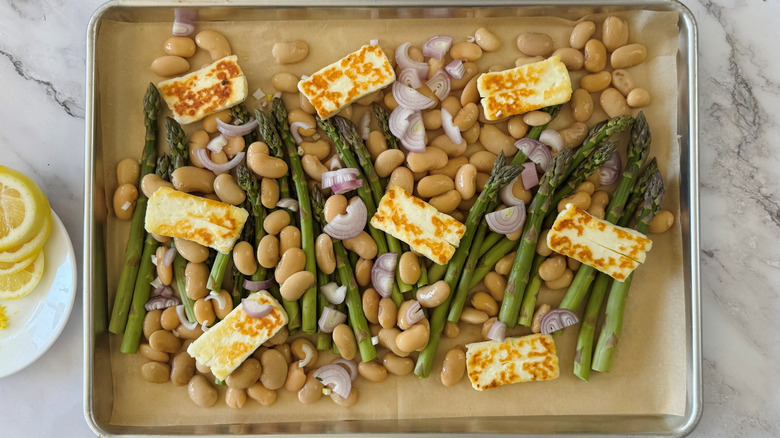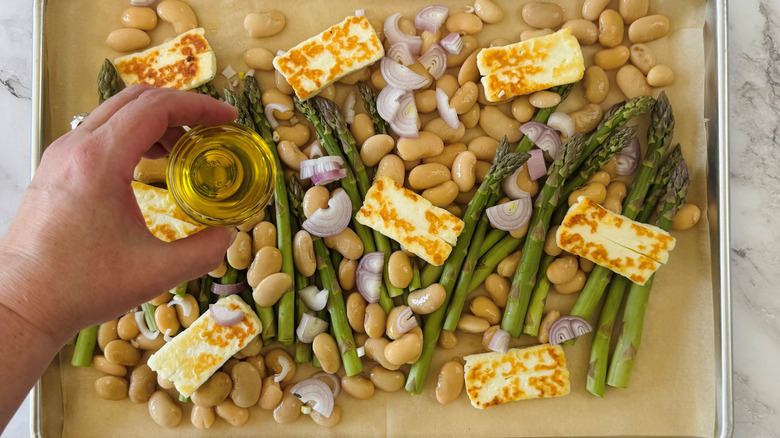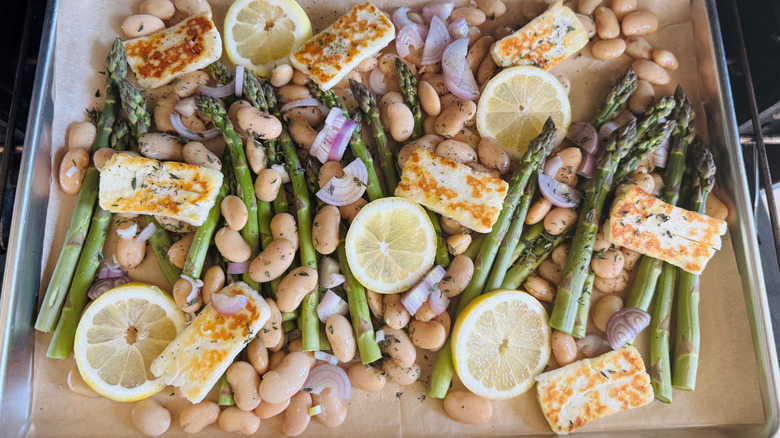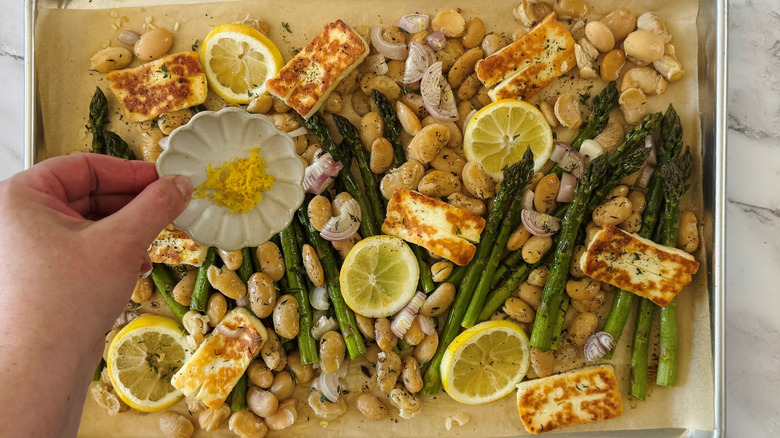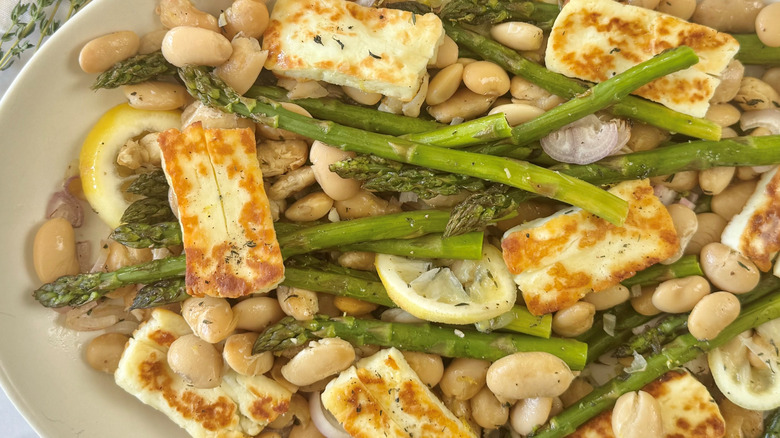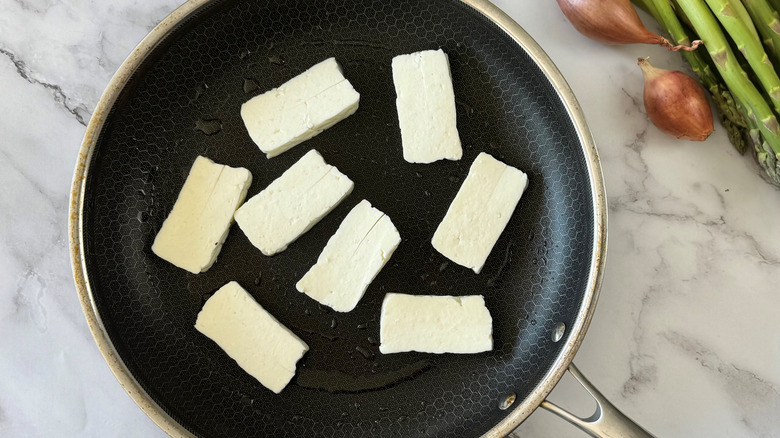Spring And Summer Sheet Pan Butter Beans Recipe
We may receive a commission on purchases made from links.
When springtime arrives, our thoughts often turn to light, nutritious meals that make the most of fresh seasonal produce through the summer. In honor of the season, recipe developer Julianne De Witt has created a dish that is based around canned butter beans and augmented with asparagus and fried halloumi cheese. "This recipe is simple, healthy, and delicious," she tells us, calling it "a great source of protein, fiber, and healthy fats." Since the beans and cheese are both nice and hearty, the dish itself can work as an entree, though it tastes equally as good as a side dish, too.
The butter beans themselves couldn't be easier to prepare (just open the can and heat), but the asparagus requires a bit more care. You need to take enough time to clean it, and De Witt also advises, "Cooking the asparagus until al dente is key, so that it gets just tender enough without becoming limp." The halloumi, too, requires an additional prep step. According to De Witt, the reason she sautes it in oil prior to adding it to the sheet pan is that this gives it a head start on browning before it goes into the oven.
Gather the ingredients for sheet pan butter beans
Halloumi cheese, asparagus, and canned butter beans are the main ingredients in this dish. You'll also need olive oil for cooking and lemon, shallots, thyme, salt, and pepper for flavoring.
Step 1: Preheat the oven
Preheat oven to 400 F.
Step 2: Cut the Halloumi cheese
Slice the halloumi into 8 equal slices
Step 3: Heat the oil
Add 1 tablespoon of olive oil to a frying pan and place over medium heat.
Step 4: Fry the cheese
Add the halloumi and brown on both sides, approximately 1 minute per side. Then remove halloumi from pan and set aside.
Step 5: Prepare the asparagus
Trim the woody ends off the asparagus.
Step 6: Slice the shallots
Peel and cut the shallots into thin slices.
Step 7: Zest the lemon
Use a microplane to zest the lemon. Set the zest aside.
Step 8: Slice the lemon
Cut the lemon into thin slices.
Step 9: Put the asparagus onto a sheet pan
Add the asparagus to a parchment lined baking sheet.
Step 10: Top the asparagus with butter beans
Evenly spread the butter beans over the asparagus.
Step 11: Add the halloumi and shallots
Place the halloumi slices and shallots on top.
Step 12: Pour on some olive oil
Drizzle the 2 remaining tablespoons of olive oil over top.
Step 13: Add the thyme, salt, and pepper
Sprinkle the thyme over the vegetables and beans and season to taste with salt and pepper.
Step 14: Cook the vegetables and cheese
Bake for 15 minutes or until asparagus is al dente.
Step 15: Garnish the sheet pan butter beans with lemon zest
Sprinkle lemon zest over top and serve.
Pairs well with sheet pan butter beans
Spring and Summer Sheet Pan Butter Beans Recipe
This sheet pan recipe comes loaded with butter beans, asparagus, and even halloumi cheese for some added savory goodness.

Ingredients
- 9 ounces halloumi cheese
- 3 tablespoons olive oil, divided
- 1 pound asparagus
- 2 small shallots
- 1 lemon
- 1 (28-ounce) can butter beans, drained and rinsed
- 1 tablespoon minced thyme
- Salt, to taste
- Pepper, to taste
Directions
- Preheat oven to 400 F.
- Slice the halloumi into 8 equal slices
- Add 1 tablespoon of olive oil to a frying pan and place over medium heat.
- Add the halloumi and brown on both sides, approximately 1 minute per side. Then remove halloumi from pan and set aside.
- Trim the woody ends off the asparagus.
- Peel and cut the shallots into thin slices.
- Use a microplane to zest the lemon. Set the zest aside.
- Cut the lemon into thin slices.
- Add the asparagus to a parchment lined baking sheet.
- Evenly spread the butter beans over the asparagus.
- Place the halloumi slices and shallots on top.
- Drizzle the 2 remaining tablespoons of olive oil over top.
- Sprinkle the thyme over the vegetables and beans and season to taste with salt and pepper.
- Bake for 15 minutes or until asparagus is al dente.
- Sprinkle lemon zest over top and serve.
Nutrition
| Calories per Serving | 530 |
| Total Fat | 25.8 g |
| Saturated Fat | 10.4 g |
| Trans Fat | 0.0 g |
| Cholesterol | 56.8 mg |
| Total Carbohydrates | 53.2 g |
| Dietary Fiber | 13.7 g |
| Total Sugars | 7.2 g |
| Sodium | 996.8 mg |
| Protein | 26.0 g |
What are butter beans and what do they taste like?
Butter beans are the seeds of a plant called Phaseolus lunatus, with the second part of the name, a Latin word for half moon, referring to the shape of the bean. Some of the other names by which these beans are known include butter peas, chad beans, gigante beans, and Madagascar beans. They are a product of the New World and were first known in Peru some 8000 years ago. Along with corn and squash, butter beans made up the Three Sisters that were a staple of Native American diets.
Butter beans and lima beans are technically the same thing since they come from the same plant, but there's a little controversy about this categorization. Some people are adamant that these two beans look and taste completely different, which may be due to the fact that butter beans are often picked at a more mature stage and, as a result, can be larger with a white or beige color. Lima beans, on the other hand, may be mistaken for edamame because they are often picked when smaller and still green. This type of lima bean may also have a more vegetal flavor, while butter beans taste, well, a bit more buttery with a creamy texture and a mild flavor.
What is halloumi, and what other types of cheese could I use?
Halloumi is a semi-hard cheese that originated in Cyprus. It was traditionally made from sheep and goat's milk, but these days it may contain over 75% cow's milk since this makes it more economical to produce. It has a mild yet salty flavor, and certain varieties may even taste slightly of mint since this ingredient is sometimes added to mimic the mint leaves in which the cheese was once wrapped. When eaten raw, halloumi may tend to have a slightly rubbery texture. It's often fried or grilled, though, since this makes it crispy outside while it goes soft and melty inside.
If you're looking for a halloumi substitute with a similar ability to stand up to high temperatures, mozzarella may be your best bet. If you're more concerned with flavor than the texture, you can also use feta or parmesan cheese as halloumi substitutes in this recipe. It's best to skip the pan-frying step with the latter two options, although you could stick with pan-frying if you use fresh mozzarella cheese.
